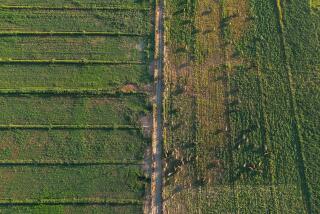Woman in Coma Dies; Chemical Link Probed
- Share via
BURBANK — A 36-year-old Toluca Lake woman who had been in a coma for more than two weeks died Tuesday as state investigators tried to determine if she was gassed by a controversial pesticide used in a nearby home connected to hers by pipes.
Sandra Mero, an assistant with an entertainment company, died at St. Joseph’s Medical Center surrounded by family and friends, a hospital spokeswoman said.
Mero had been in critical condition since she was found unconscious in her home March 8 and had been expected die, said Bill Walker, a family friend.
Walker, a San Francisco Bay Area environmentalist, has been involved in the controversy surrounding methyl bromide, a poisonous gas widely used in agriculture to protect soil from crop-eating pests and to fumigate houses and commercial buildings to kill insects. Environmentalists have tried for years to have the gas outlawed, but a proposed state ban has been twice postponed by the Legislature at the insistence of farmers and the pest-control industry.
The California Department of Pesticide Regulation has begun an investigation to determine if Mero was a victim of methyl bromide. A Burbank company has said the gas was used to fumigate a house next door to hers--which turned out to be connected to Mero’s home by seven pipes.
If it is found that the methyl bromide was involved, Mero would be the 19th person to die of the gas in California during the past 13 years, according to state records, which also list hundreds of illnesses blamed on the chemical. Many were burglars or homeless people who entered fumigated buildings while the gas was present.
Mero lived in a house in a compound of buildings in the 10400 block of West Valley Spring Lane.
On March 8, she told friends by telephone that she awoke feeling ill, according Larry Feldman, her lawyer. He said she went back to sleep and was found unconscious the next day by her landlord, Sally Stevens.
Feldman said Mero’s home was connected by pipes one to two inches in diameter to a studio 15 feet away on the same compound, where methyl bromide had been used the day before as a fumigant. The purpose of the pipes was unclear, but sources said it was believed that they had been used years ago to carry electrical wires between the buildings.
The operator of the Burbank company that carried out the fumigation said the pipes were very unusual and went unseen before the gas was used.
State officials have not said whether methyl bromide is to blame for Mero’s death. But a relative of the woman said doctors indicated they found 27 parts per million of methyl bromide in her blood--well above the lethal dose of 24 ppm.
The fumigant attacks the central nervous and respiratory systems, bringing dizziness, vomiting and disorientation to people who breathe its fumes.
Environmentalists have painted it as dangerous, particularly to farm laborers who work with it and harvest crops in some areas of California where the chemical has been injected into the ground.
Its use would have been illegal in California if a ban that was to go into effect in March 1996 had not been delayed by the state Legislature. Lawmakers acted at the request of farm groups and Gov. Pete Wilson, who called a special legislative session to deal with the issue.
The potential financial losses resulting from the chemical’s elimination were estimated at $346 million from smaller harvests, plus $241 million in lost exports--which the state Department of Food and Agriculture said would lead to the loss of 10,000 jobs.
However, the fumigant must be outlawed in 2001 in the United States and many other countries under an international agreement signed in Montreal in 1993 because of fears that it damages the Earth’s ozone layer--the thin cover in the atmosphere that protects living things from harmful solar rays.
More to Read
Sign up for Essential California
The most important California stories and recommendations in your inbox every morning.
You may occasionally receive promotional content from the Los Angeles Times.










